
Timeline for aircraft carrier service
Encyclopedia

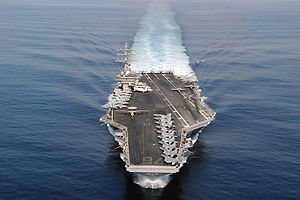
World War I
World War I , which was predominantly called the World War or the Great War from its occurrence until 1939, and the First World War or World War I thereafter, was a major war centred in Europe that began on 28 July 1914 and lasted until 11 November 1918...
. The earliest experiments constisted of fitting temporary "flying off" platforms to the gun turrets of the warships of several nations, notably the United States
United States
The United States of America is a federal constitutional republic comprising fifty states and a federal district...
and the United Kingdom
United Kingdom
The United Kingdom of Great Britain and Northern IrelandIn the United Kingdom and Dependencies, other languages have been officially recognised as legitimate autochthonous languages under the European Charter for Regional or Minority Languages...
. The first ship to be modified with a permanent flight deck was the light cruiser which initially had a single flying off deck forward of the original superstructure. Subsequently she was modified with a separate "landing on" deck aft and later with a full flush deck. Other ships, often liners, were modified to have full flush flight decks, being the first to have such modification begun. Those first faltering steps gave little indication of just how important the aircraft carrier was to prove to be. During the inter-war years (between the World Wars), Japan
Japan
Japan is an island nation in East Asia. Located in the Pacific Ocean, it lies to the east of the Sea of Japan, China, North Korea, South Korea and Russia, stretching from the Sea of Okhotsk in the north to the East China Sea and Taiwan in the south...
, the United Kingdom and the United States built up significant carrier fleets so that by the beginning of World War II
World War II
World War II, or the Second World War , was a global conflict lasting from 1939 to 1945, involving most of the world's nations—including all of the great powers—eventually forming two opposing military alliances: the Allies and the Axis...
, they had 18 carriers between them. The 1940 Battle of Taranto
Battle of Taranto
The naval Battle of Taranto took place on the night of 11–12 November 1940 during the Second World War. The Royal Navy launched the first all-aircraft ship-to-ship naval attack in history, flying a small number of obsolescent biplane torpedo bombers from an aircraft carrier in the Mediterranean Sea...
and the 1941 Attack on Pearl Harbor
Attack on Pearl Harbor
The attack on Pearl Harbor was a surprise military strike conducted by the Imperial Japanese Navy against the United States naval base at Pearl Harbor, Hawaii, on the morning of December 7, 1941...
in retrospect showed the world that the aircraft carrier was to be the most important ship in the modern fleet. Today, aircraft carriers are the capital ship
Capital ship
The capital ships of a navy are its most important warships; they generally possess the heaviest firepower and armor and are traditionally much larger than other naval vessels...
s of the navies they serve in, and in the case of modern US "supercarriers", they embark an airgroup that is effectively a small air force.
This timeline is an attempt to provide a unified chronology of key dates in carrier service. Aircraft carriers often serve their navies for many decades and this chronology enables the reader to track the progress of the carrier as it has developed alongside the evolution of aircraft for nearly a hundred years.
Pre-Carrier History
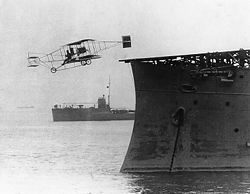
- The British Admiralty, according to legend, politely refused the Wright brothersWright brothersThe Wright brothers, Orville and Wilbur , were two Americans credited with inventing and building the world's first successful airplane and making the first controlled, powered and sustained heavier-than-air human flight, on December 17, 1903...
' offer to sell them one or more aircraft, by saying that they could see no place for aviation in naval circles.
1910
- 14 November — First successful launch of an aircraft from a ship, using a temporary wooden platform for a flight deckFlight deckThe flight deck of an aircraft carrier is the surface from which its aircraft take off and land, essentially a miniature airfield at sea. On smaller naval ships which do not have aviation as a primary mission, the landing area for helicopters and other VTOL aircraft is also referred to as the...
on the cruiserCruiserA cruiser is a type of warship. The term has been in use for several hundreds of years, and has had different meanings throughout this period...
.
1911
- 18 January — First deck landing, using a temporary wooden platform on ; first use of a tailhookTailhookA tailhook, also arresting hook or arrester hook, is a device attached to the empennage of some military fixed wing aircraft...
-arrested landing system.
1912
- January — First launch of an aircraft from a British ship, .
- 2 May — First recorded flight from a moving ship, , steaming at 10.5 knots.
World War I
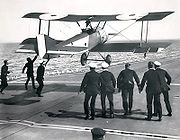
- 28 June — Assassination of Archduke Franz Ferdinand; World War IWorld War IWorld War I , which was predominantly called the World War or the Great War from its occurrence until 1939, and the First World War or World War I thereafter, was a major war centred in Europe that began on 28 July 1914 and lasted until 11 November 1918...
begins. - October — First aircraft carrying ship to be sunk in action, (former cruiser) seaplane carrier sunk by U-27.
- 25 December — Attack on CuxhavenCuxhaven RaidThe Cuxhaven Raid was a British ship-based air-raid on the German naval forces at Cuxhaven mounted on Christmas Day, 1914.Aircraft of the Royal Naval Air Service were carried to within striking distance by seaplane tenders of the Royal Navy, supported by both surface ships and submarines...
, the first attack from the sea upon a land target using aircraft (seaplaneSeaplaneA seaplane is a fixed-wing aircraft capable of taking off and landing on water. Seaplanes that can also take off and land on airfields are a subclass called amphibian aircraft...
s).
1915
- 12 August — First attack using an air-launched torpedoTorpedoThe modern torpedo is a self-propelled missile weapon with an explosive warhead, launched above or below the water surface, propelled underwater towards a target, and designed to detonate either on contact with it or in proximity to it.The term torpedo was originally employed for...
, from a Short Type 184Short Type 184|-Manufacturers:Source: Barnes and James#Brush Electrical Engineering Co. Ltd. #Frederick Sage & Co. Ltd. #J. Samuel White #Mann, Egerton & Co. Ltd. #Phoenix Dynamo Manufacturing Company #Robey & Co. Ltd. #S E Saunders Limited...
seaplane flown by Flight Commander Charles H. K. Edmonds from seaplane carrier . - 5 November — First catapultAircraft catapultAn aircraft catapult is a device used to launch aircraft from ships—in particular aircraft carriers—as a form of assisted take off. It consists of a track built into the flight deck, below which is a large piston or shuttle that is attached through the track to the nose gear of the aircraft, or in...
launch of an aircraft from a ship, .
1916
- May 31 — First use of an aeroplane during a battle at sea, the Battle of JutlandBattle of JutlandThe Battle of Jutland was a naval battle between the British Royal Navy's Grand Fleet and the Imperial German Navy's High Seas Fleet during the First World War. The battle was fought on 31 May and 1 June 1916 in the North Sea near Jutland, Denmark. It was the largest naval battle and the only...
. - August — Incomplete Italian linerOcean linerAn ocean liner is a ship designed to transport people from one seaport to another along regular long-distance maritime routes according to a schedule. Liners may also carry cargo or mail, and may sometimes be used for other purposes .Cargo vessels running to a schedule are sometimes referred to as...
Conte Rosso purchased by the Royal NavyRoyal NavyThe Royal Navy is the naval warfare service branch of the British Armed Forces. Founded in the 16th century, it is the oldest service branch and is known as the Senior Service...
for completion and conversion to an aircraft carrier, .
1917
- February — Incomplete large light cruiserLight cruiserA light cruiser is a type of small- or medium-sized warship. The term is a shortening of the phrase "light armored cruiser", describing a small ship that carried armor in the same way as an armored cruiser: a protective belt and deck...
has its forward gun replaced with a flying-off deckFlight deckThe flight deck of an aircraft carrier is the surface from which its aircraft take off and land, essentially a miniature airfield at sea. On smaller naval ships which do not have aviation as a primary mission, the landing area for helicopters and other VTOL aircraft is also referred to as the...
. - 19 July — Tondern raidTondern raidThe Tondern raid, officially designated Operation F.7, was a British bombing raid mounted by the Royal Navy and Royal Air Force against the Imperial German Navy's airship base at Tondern in Germany. It was the first attack in history made by aircraft flying from a carrier flight deck. On 19 July...
, the first attack by aircraft launched from a carrier flight deck. - 2 August — First aircraft landing aboard a moving ship, HMS Furious; this ship was subsequently modified with a stern-mounted landing deck in late 1917.
- 21 August — First air to air kill from a ship launched aircraft, ZeppelinZeppelinA Zeppelin is a type of rigid airship pioneered by the German Count Ferdinand von Zeppelin in the early 20th century. It was based on designs he had outlined in 1874 and detailed in 1893. His plans were reviewed by committee in 1894 and patented in the United States on 14 March 1899...
L23 shot down by a Sopwith PupSopwith PupThe Sopwith Pup was a British single seater biplane fighter aircraft built by the Sopwith Aviation Company. It entered service with the Royal Flying Corps and the Royal Naval Air Service in the autumn of 1916. With pleasant flying characteristics and good maneuverability, the aircraft proved very...
from cruiser . - 2 December — HMS Argus launched.
1918
- 15 January — laid downKeelIn boats and ships, keel can refer to either of two parts: a structural element, or a hydrodynamic element. These parts overlap. As the laying down of the keel is the initial step in construction of a ship, in British and American shipbuilding traditions the construction is dated from this event...
; Hermes was the first ship specifically designed to be built as an aircraft carrier and the first carrier to feature an island superstructure. - 28 February — Incomplete Chilean battleshipBattleshipA battleship is a large armored warship with a main battery consisting of heavy caliber guns. Battleships were larger, better armed and armored than cruisers and destroyers. As the largest armed ships in a fleet, battleships were used to attain command of the sea and represented the apex of a...
Almirante Cochrane purchased by the Royal Navy to be completed as the carrier . - 8 June — HMS Eagle launched.
- 9 July — First strike by aircraft launched from a carrier, the Tondern raidTondern raidThe Tondern raid, officially designated Operation F.7, was a British bombing raid mounted by the Royal Navy and Royal Air Force against the Imperial German Navy's airship base at Tondern in Germany. It was the first attack in history made by aircraft flying from a carrier flight deck. On 19 July...
. - 14 September — HMS Argus commissionedShip commissioningShip commissioning is the act or ceremony of placing a ship in active service, and may be regarded as a particular application of the general concepts and practices of project commissioning. The term is most commonly applied to the placing of a warship in active duty with its country's military...
. - 11 November — ArmisticeArmistice with Germany (Compiègne)The armistice between the Allies and Germany was an agreement that ended the fighting in the First World War. It was signed in a railway carriage in Compiègne Forest on 11 November 1918 and marked a victory for the Allies and a complete defeat for Germany, although not technically a surrender...
signed, signalling the end of WWI.
Between the wars
1919- 11 July — authorised to be converted to a carrier.
- 11 September — HMS Hermes launched.
- 16 December — HōshōJapanese aircraft carrier HoshoHōshō |phoenix]]") was the world's first commissioned ship that was designed and built as an aircraft carrier,The HMS Argus pre-dated Hōshō and had a long landing deck, but was designed and initially built as an ocean liner. and the first aircraft carrier of the Imperial Japanese Navy...
laid down, possibly as the tankerTank shipA tanker is a ship designed to transport liquids in bulk. Major types of tankship include the oil tanker, the chemical tanker, and the liquefied natural gas carrier.-Background:...
Hiryu.
1920
.jpg)
- 24 March — USS Jupiter decommissioned for conversion to a carrier.
- 21 April — USS Jupiter renamed .
- 1 November — U.S. Navy sinks during an exercise testing aerial bombardment.
- 6 December — Japanese aircraft carrier AkagiJapanese aircraft carrier AkagiAkagi was an aircraft carrier of the Imperial Japanese Navy , originally begun as an . She was converted while still under construction to an aircraft carrier under the terms of the Washington Naval Treaty...
laid down.
1921
- 13 November — Hōshō launched.
1922
- 6 February — Washington Naval TreatyWashington Naval TreatyThe Washington Naval Treaty, also known as the Five-Power Treaty, was an attempt to cap and limit, and "prevent 'further' costly escalation" of the naval arms race that had begun after World War I between various International powers, each of which had significant naval fleets. The treaty was...
limiting naval forces signed. - HMS Furious flush-deck conversion begun.
- 20 March — USS Langley commissioned.
- 1 July — Battle cruisers and reclassified to be completed as carriers.
- 27 December — Hōshō commissioned.
1923

- July – HMS Hermes commissioned
- August – Conversion of the French Normandie-class battleshipNormandie class battleshipThe Normandie-class dreadnought battleships were ordered for the French Navy before the First World War. They were named after provinces of France. These ships were never completed as battleships because the war stopped their construction...
BéarnFrench aircraft carrier BéarnBéarn was a unique aircraft carrier which served with the Marine nationale in World War II and beyond.Béarn was commissioned in 1927 and was the only aircraft carrier produced by France until after World War II. She was to be an experimental ship and should have been replaced in the 1930s by two...
to an aircraft carrier started. - KagaJapanese aircraft carrier KagaKaga was an aircraft carrier of the Imperial Japanese Navy , named after the former Kaga Province in present-day Ishikawa Prefecture...
carrier conversion begun.
1924
- 26 February — HMS Eagle commissioned.
- June — Light cruiser carrier conversion started.
1925

- Light cruiser carrier conversion started.
- 7 April — USS Saratoga launched.
- 22 April — Akagi launched.
- 1 July — First night deck landing made by F/Lt Boyce flying a Blackburn DartBlackburn Dart-See also:-Bibliography:* Jackson, A.J. Blackburn Aircraft since 1909. London:Putnam, 1968. ISBN 0-370-00053-6.* Mason, Francis K. The British Bomber since 1914. London:Putnam, 1994. ISBN 0-85177-861-5....
onto HMS Furious - September — HMS Furious re-enters service with flush flight deck.
- 3 October — USS Lexington launched.
1926
- 6 May — First night deck landing, aboard .
1927
- 25 March — Akagi commissioned
- May — Béarn commissioned.
- 16 November — USS Saratoga commissioned.
- 14 December — USS Lexington commissioned.
1928
.jpg)
- 5 May — HMS Courageous commissioned as a carrier; first carrier to be fitted with transverse arrestor gearArresting gearArresting gear, or arrestor gear, is the name used for mechanical systems designed to rapidly decelerate an aircraft as it lands. Arresting gear on aircraft carriers is an essential component of naval aviation, and it is most commonly used on CATOBAR and STOBAR aircraft carriers. Similar systems...
(friction-based). - 31 March — Kaga commissioned.
1929
- 26 November — RyūjōJapanese aircraft carrier RyujoRyūjō was a light aircraft carrier of the Imperial Japanese Navy. She was laid down by Mitsubishi at Yokohama in 1929, launched in 1931 and commissioned on 9 May 1933. Her final design resulted in a top-heavy unstable vessel and within a year she was back at Kure Naval Yard for modification...
laid down.
1930
- 10 March — HMS Glorious recommissioned as an aircraft carrier.
- March — HMS Argus placed in reserve.
1931
- 2 January — First carrier fitted with hydraulic arresting gear, HMS Courageous.
- 2 April — Ryūjō launched.
- 26 September – laid down.
1933
- 25 February — USS Ranger launched.
- 9 May — Ryūjō commissioned.
1934
_in_puget_sound,_september_1945.jpg)
- 21 May — laid down.
- 4 June — USS Ranger commissioned.
- 16 July — laid down.
- 20 November — SōryūJapanese aircraft carrier Soryuwas an aircraft carrier of the Imperial Japanese Navy. During the Second World War, she took part in the attack on Pearl Harbor, Wake Island, Port Darwin and raids in the Indian Ocean before being sunk at the Battle of Midway.-Design:...
laid down.
1935
- 9 September – First landing of a rotary winged aircraft aboard a carrier – a Cierva autogyro onto HMS Furious
- 16 September — laid down.
- 21 December — Sōryū launched.
1936
- January 15 — Japan exits the Washington Naval Treaty.
- 1 April — laid down.
- 4 April — USS Yorktown launched.
- 8 July — HiryūJapanese aircraft carrier Hiryuwas a modified Sōryū-class aircraft carrier of the Imperial Japanese Navy. She was one of the carriers that began the Pacific War with the attack on Pearl Harbor...
laid down. - 3 October — USS Enterprise launched.
- 25 October — USS Langley taken in hand for conversion to a seaplane tenderSeaplane tenderA seaplane tender is a ship that provides facilities for operating seaplanes. These ships were the first aircraft carriers and appeared just before the First World War.-History:...
. - 28 December — Flugzeugträger AGerman aircraft carrier Graf ZeppelinGerman aircraft carrier Graf Zeppelin was the lead ship in a class of two carriers ordered by the Kriegsmarine. She was the only aircraft carrier launched by Germany during World War II and represented part of the Kriegsmarine's attempt to create a well-balanced oceangoing fleet, capable of...
(Graf Zeppelin) laid down.
1937

- 29 January — Sōryū commissioned.
- 26 February — USS Langley recommissioned as a seaplane tender.
- 13 April — HMS Ark Royal launched.
- 27 April — laid down.
- 4 May — laid down.
- 17 June — laid down.
- 30 September — USS Yorktown commissioned.
- 10 November — laid down.
- 16 November — Hiryū launched.
- 12 December — ShōkakuJapanese aircraft carrier ShokakuShōkaku was an aircraft carrier of the Imperial Japanese Navy, the lead ship of her class. Along with her sister ship , she took part in several key naval battles during the Pacific War, including the attack on Pearl Harbor, the Battle of the Coral Sea and the Battle of the Santa Cruz Islands...
laid down.
1938

- TakasakiJapanese aircraft carrier Zuihowas a light aircraft carrier of the Imperial Japanese Navy. During the Second World War, she participated in many operations, including the battles of Santa Cruz, Philippine Sea and Leyte Gulf where she was finally sunk by American aircraft.-Design:...
carrier conversion started. - Flugzeugträger BFlugzeugträger BThe Flugzeugträger B was the sister ship of the Kriegsmarine's only launched aircraft carrier, the Graf Zeppelin....
laid down. - 12 May — USS Enterprise commissioned.
- 25 May — ZuikakuJapanese aircraft carrier ZuikakuZuikaku was a Shōkaku-class aircraft carrier of the Imperial Japanese Navy. Her complement of aircraft took part in the attack on Pearl Harbor that formally brought the United States into the Pacific War, and she fought in several of the most important naval battles of the war, finally being sunk...
laid down. - 8 December — Graf Zeppelin launched.
- 16 December — HMS Ark Royal commissioned; first carrier with deck armour.
1939
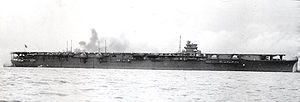
- 21 February — laid down.
- 4 April — USS Wasp launched.
- 5 April — HMS Illustrious launched.
- 1 June — Shōkaku launched.
- 26 June — laid down.
- 5 July — Hiryū commissioned.
- 17 August — HMS Formidable launched.
World War II
1939
- 1 September — Germany invades Poland, World War IIWorld War IIWorld War II, or the Second World War , was a global conflict lasting from 1939 to 1945, involving most of the world's nations—including all of the great powers—eventually forming two opposing military alliances: the Allies and the Axis...
begins. - 14 September — HMS Victorious launched.
- 17 September — HMS Courageous sunk in action.
- 25 September — laid down.
- 26 September — First Allied air victory in WWII, a Dornier Do 18Dornier Do 18The Dornier Do 18 was a development of the Do 16 flying boat. It was developed for the Luftwaffe, but Lufthansa got 5 aircraft and used these for tests between the Azores and the North American continent in 1936 and on their mail route over the South Atlantic from 1937 to 1939.27–29 March 1938 a...
shot down by Lt B.S. McEwan flying a Blackburn SkuaBlackburn SkuaThe Blackburn B-24 Skua was a carrier-based low-wing, two-seater, single-radial engine aircraft operated by the British Fleet Air Arm which combined the functions of a dive bomber and fighter. It was designed in the mid-1930s, and saw service in the early part of the Second World War...
of 803 Squadron803 Naval Air Squadron803 Naval Air Squadron was a Royal Navy Fleet Air Arm squadron.-Interwar:803 NAS was formed on 3 April 1933 by promoting No 409 Flight to the status of a squadron, with nine Ospreys...
from HMS Ark Royal. - 27 November — Zuikaku launched.
- 3 November — laid down.
1940
- Idzumo MaruJapanese aircraft carrier HiyoHiyō was a of the Imperial Japanese Navy. Begun as an ocean liner in 1939, she was purchased by the Navy Ministry in 1941 for conversion to an aircraft carrier...
carrier conversion started, renamed HiyōJapanese aircraft carrier HiyoHiyō was a of the Imperial Japanese Navy. Begun as an ocean liner in 1939, she was purchased by the Navy Ministry in 1941 for conversion to an aircraft carrier...
. - Kashiwara MaruJapanese aircraft carrier Junyowas a of the Imperial Japanese Navy. She was laid down at Nagasaki as the passenger liner Kashiwara Maru, but was purchased by the Japanese Navy in 1941 and converted to an aircraft carrier. Completed in May 1942, the ship participated in the invasion of the Aleutian Islands the following month...
carrier conversion started, renamed JunyōJapanese aircraft carrier Junyowas a of the Imperial Japanese Navy. She was laid down at Nagasaki as the passenger liner Kashiwara Maru, but was purchased by the Japanese Navy in 1941 and converted to an aircraft carrier. Completed in May 1942, the ship participated in the invasion of the Aleutian Islands the following month...
. - HMS Argus recommissioned as training and transport carrier.
- 28 February — Flugzeugträger B cancelled while under construction.
- 26 March — HMS Indomitable launched.
- 25 April — USS Wasp commissioned.
.jpg)
- May — Graf Zeppelin construction temporarily suspended.
- 25 May — HMS Illustrious commissioned; first fully armoured carrier.
- June — Béarn interned at MartiniqueMartiniqueMartinique is an island in the eastern Caribbean Sea, with a land area of . Like Guadeloupe, it is an overseas region of France, consisting of a single overseas department. To the northwest lies Dominica, to the south St Lucia, and to the southeast Barbados...
. - 18 June — HMS Glorious sunk in action.
- 21 June — Attack on Scharnhorst, first ever torpedo attack by aircraft on a capital ship at sea.
- 25 June — FranceMilitary history of France during World War IIThe military history of France during World War II covers the period from 1939 until 1940, which witnessed French military participation under the French Third Republic , and the period from 1940 until 1945, which was marked by mainland and overseas military administration and influence struggles...
falls to Germany. - 11 November — Battle of TarantoBattle of TarantoThe naval Battle of Taranto took place on the night of 11–12 November 1940 during the Second World War. The Royal Navy launched the first all-aircraft ship-to-ship naval attack in history, flying a small number of obsolescent biplane torpedo bombers from an aircraft carrier in the Mediterranean Sea...
witnessed the first carrier-based torpedo-bomber attack. - 24 November — HMS Formidable commissioned.
- 14 December — USS Hornet launched.
- 27 December — Takasaki carrier conversion completed, commissioned as ZuihōJapanese aircraft carrier Zuihowas a light aircraft carrier of the Imperial Japanese Navy. During the Second World War, she participated in many operations, including the battles of Santa Cruz, Philippine Sea and Leyte Gulf where she was finally sunk by American aircraft.-Design:...
.
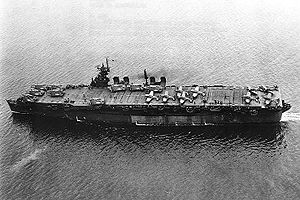
- Submarine tender TsurugisakiJapanese aircraft carrier ShohoShōhō , the lead ship of her class, was a light aircraft carrier of the Imperial Japanese Navy during World War II...
carrier conversion started. - Italian passenger liner Roma carrier conversion started, renamed AquilaItalian aircraft carrier AquilaAquila was an Italian aircraft carrier converted from the trans-Atlantic passenger liner during World War II. Work on Aquila began in late 1941 at the Ansaldo shipyard in Genoa and continued for the next two years. With the signing of the Italian armistice on 8 September 1943, however, all work...
- 28 April — laid down.
- May — Incomplete passenger liners Kasuga MaruJapanese aircraft carrier TaiyoTaiyō was the lead ship of Taiyō-class of escort carrier operated by the Imperial Japanese Navy in World War II.-Construction and Conversion:...
, Yawata MaruJapanese aircraft carrier UnyoUnyō was a Taiyō-class escort carrier operated by the Imperial Japanese Navy in World War II.-Construction and conversion:The liner of the shipping line Nippon Yusen, laid down in the Mitsubishi shipyard in Nagasaki in December 1938, launched in October 1939 and commissioned in July 1940, was...
and Nitta MaruJapanese aircraft carrier ChuyoChūyō was a Taiyō-class escort carrier operated by the Imperial Japanese Navy in World War II.-Construction and Conversion:The was an ocean liner of the Nippon Yusen shipping line, laid down in the Mitsubishi shipyard in Nagasaki in May 1938, launched in May 1939 and commissioned on 23 March 1940...
carrier conversions started. - 1 may — laid down as light cruiser .
- 26 May — German battleship BismarckGerman battleship BismarckBismarck was the first of two s built for the German Kriegsmarine during World War II. Named after Chancellor Otto von Bismarck, the primary force behind the German unification in 1871, the ship was laid down at the Blohm & Voss shipyard in Hamburg in July 1936 and launched nearly three years later...
disabled by aircraft launched from and later sunk. - 15 May — HMS Victorious commissioned.
- 24 June — Hiyō launched.
- 26 June — Junyō launched.
- 10 July — TaihōJapanese aircraft carrier Taihowas an aircraft carrier of the Imperial Japanese Navy during World War II. With a heavily armored hull and flight deck , she represented a major departure in Japanese carrier design and was expected to not only survive multiple bomb, torpedo or shell hits but also continue fighting effectively...
laid down. - 15 July — USS CabotUSS Lexington (CV-16)USS Lexington , known as "The Blue Ghost", is one of 24 s built during World War II for the United States Navy. The ship, the fifth US Navy ship to bear the name, is named in honor of the Revolutionary War Battle of Lexington...
laid down. - 8 August — Shōkaku commissioned.
- 2 September — Kasuga Maru carrier conversion completed.
- 15 September — laid down; Kasuga Maru commissioned as TaiyōJapanese aircraft carrier TaiyoTaiyō was the lead ship of Taiyō-class of escort carrier operated by the Imperial Japanese Navy in World War II.-Construction and Conversion:...
- 25 September — Zuikaku commissioned.
- 10 October — HMS Indomitable commissioned.
- 20 October — USS Hornet commissioned.
- 13 November — HMS Ark Royal sunk in action.
.jpg)
- 20 November — HMS Unicorn launched.
- 1 December — USS Bon Homme RichardUSS Yorktown (CV-10)USS Yorktown is one of 24 s built during World War II for the United States Navy. She is named after the Battle of Yorktown of the American Revolutionary War, and is the fourth U.S. Navy ship to bear the name...
, laid down. - 7 December — Japanese attacks on Pearl HarborAttack on Pearl HarborThe attack on Pearl Harbor was a surprise military strike conducted by the Imperial Japanese Navy against the United States naval base at Pearl Harbor, Hawaii, on the morning of December 7, 1941...
naval base Hawaii and Philippines; United States enters World War II. - 20 December — Submarine tender TaigeiJapanese aircraft carrier RyuhoThe was a Japanese Light aircraft carrier. Sole ship of her class, she was converted from a submarine tender. During World War II she operated mainly as aircraft transport but did participate in the First Battle of the Philippine Sea.-Conversion and commission:...
carrier conversion started.
1942
- 26 January — Tsurugisaki carrier conversion completed, commissioned as ShōhōJapanese aircraft carrier ShohoShōhō , the lead ship of her class, was a light aircraft carrier of the Imperial Japanese Navy during World War II...
. - February — carrier conversion started by Japan.
- 16 February — Light cruisers and reclassified for completion as carriers.
- 27 February — USS Langley sunk in action.
- 16 March — USS WilmingtonUSS Cabot (CVL-28)USS Cabot was an in the United States Navy, the second ship to carry the name. Cabot was commissioned in 1943 and served until 1947. She was recommissioned as a training carrier from 1948 to 1955. From 1967 to 1989, she served in Spain as '...
laid down. - 18 March — USS OriskanyUSS Wasp (CV-18)USS Wasp was one of 24 s built during World War II for the United States Navy. The ship, the ninth US Navy ship to bear the name, was originally named Oriskany, but was renamed while under construction in honor of the previous , which was sunk 15 September 1942...
laid down.

- 27 March — Light cruisers and reclassified for completion as carriers; Huntington renamed .
- 31 March — USS Tallahassee renamed , USS New Haven renamed , USS Dayton renamed .
- 9 April — HMS Hermes sunk in action.
- 11 April — Originally intended as light cruiserLight cruiserA light cruiser is a type of small- or medium-sized warship. The term is a shortening of the phrase "light armored cruiser", describing a small ship that carried armor in the same way as an armored cruiser: a protective belt and deck...
, USS Crown PointUSS Langley (CVL-27)USS Langley was an 11,000-ton that served the United States Navy from 1943 to 1947, and French Navy as the La Fayette from 1951 to 1963. Named for Samuel Pierpont Langley, American scientist and aviation pioneer, Langley received nine battle stars for World War II service...
laid down. - May — Béarn demilitarised; Graf Zeppelin construction resumed
- 4 May — Battle of the Coral SeaBattle of the Coral SeaThe Battle of the Coral Sea, fought from 4–8 May 1942, was a major naval battle in the Pacific Theater of World War II between the Imperial Japanese Navy and Allied naval and air forces from the United States and Australia. The battle was the first fleet action in which aircraft carriers engaged...
commences – first carrier-to-carrier naval engagement in history, and first naval engagement where neither fleet directly fired upon nor came within sight of the other fleet. - 5 May — Junyō commissioned.
- 7 May — Shōhō sunk in action.

- 8 May — USS Lexington sunk in action; Battle of the Coral Sea ends.
- 31 May — Yawata Maru carrier conversion completed, commissioned as UnyōJapanese aircraft carrier UnyoUnyō was a Taiyō-class escort carrier operated by the Imperial Japanese Navy in World War II.-Construction and conversion:The liner of the shipping line Nippon Yusen, laid down in the Mitsubishi shipyard in Nagasaki in December 1938, launched in October 1939 and commissioned in July 1940, was...
. - June — Incomplete Yamato classYamato class battleshipThe were battleships of the Imperial Japanese Navy constructed and operated during World War II. Displacing at full load, the vessels were the heaviest and most powerfully armed battleships ever constructed. The class carried the largest naval artillery ever fitted to a warship, nine naval...
battleship ShinanoJapanese aircraft carrier Shinanonamed after the ancient Shinano Province, was an aircraft carrier of the Imperial Japanese Navy during World War II. Initially laid down as the third of the battleships, Shinano′s partially complete hull was converted to an aircraft carrier in 1942, midway through construction. Over the next two...
carrier conversion started. - 1 June — laid down, and HMS EdgarHMS Perseus (R51)HMS Perseus was a light fleet aircraft carrier built for the Royal Navy during World War II. The ship was initially named Edgar, but she was renamed in 1944 when the Admiralty decided to convert her into an aircraft maintenance carrier. She was completed in 1945, after the end of World War II, and...
laid down. - 4 June — Battle of MidwayBattle of MidwayThe Battle of Midway is widely regarded as the most important naval battle of the Pacific Campaign of World War II. Between 4 and 7 June 1942, approximately one month after the Battle of the Coral Sea and six months after Japan's attack on Pearl Harbor, the United States Navy decisively defeated...
commenced, generally considered to be the most important naval battle in the Pacific during World War II; Akagi, Kaga, Sōryū severely damaged in action, with Kaga and Sōryū subsequently scuttledScuttlingScuttling is the act of deliberately sinking a ship by allowing water to flow into the hull.This can be achieved in several ways—valves or hatches can be opened to the sea, or holes may be ripped into the hull with brute force or with explosives...
. - 5 June — Hiryū sunk in action, Akagi scuttled.
- 7 June — USS Yorktown sunk in action; Battle of Midway ended.
- 16 June — USS Cabot renamed .
- 23 June — USS Wilmington renamed .
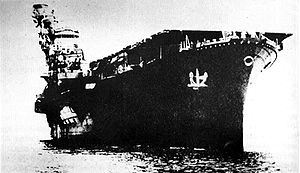
- 31 July — Hiyō commissioned; USS Essex launched.
- 1 August — UnryūJapanese aircraft carrier UnryuThe Japanese aircraft carrier was a fleet aircraft carrier of the Imperial Japanese Navy which served during World War II. She was commissioned on 6 August 1944 and eventually torpedoed and sunk by US submarine in the East China Sea on 19 December that same year...
laid down. - 3 August — USS KearsargeUSS Hornet (CV-12)USS Hornet is a United States Navy aircraft carrier of the Essex class. Construction started in August 1942; she was originally named , but was renamed in honor of the , which was lost in October 1942, becoming the eighth ship to bear the name.Hornet was commissioned in November 1943, and after...
laid down. - 11 August — HMS Eagle sunk in action.
- 22 August — USS Independence launched.
- 24 August — Ryūjō sunk in action.
- 27 August — laid down.
- 31 August — laid down; Kasuga Maru reclassified as warship;
_brennt.jpg)
- 15 September — USS Wasp sunk in action.
- 26 September — USS Bon Homme Richard renamed ; USS Lexington launched.
- 1 October — AmagiJapanese aircraft carrier Amagiwas a of the Imperial Japanese Navy built during World War II. Named after Mount Amagi, and completed late in the war; she never embarked her complement of aircraft and did not participate in any battles. The ship capsized in July 1945 after being hit multiple times during airstrikes by American...
laid down. - 18 October — USS Princeton launched.
- 24 October — laid down.
- 26 October — USS ReprisalUSS San Jacinto (CVL-30)The second USS San Jacinto of the United States Navy was an Independence-class light aircraft carrier that served during World War II. She was named for the Battle of San Jacinto during the Texas Revolution. U.S. President George H.W...
laid down. - 27 October — USS Hornet sunk in action.
- 8 November — laid down.
- 12 November — laid down.
- 13 November — USS Crown Point renamed , USS Oriskany renamed .
- 25 November — Nitta Maru carrier conversion completed, renamed and commissioned as ChūyōJapanese aircraft carrier ChuyoChūyō was a Taiyō-class escort carrier operated by the Imperial Japanese Navy in World War II.-Construction and Conversion:The was an ocean liner of the Nippon Yusen shipping line, laid down in the Mitsubishi shipyard in Nagasaki in May 1938, launched in May 1939 and commissioned on 23 March 1940...
. - 28 November — Taigei carrier conversion completed, renamed and commissioned as RyūhōJapanese aircraft carrier RyuhoThe was a Japanese Light aircraft carrier. Sole ship of her class, she was converted from a submarine tender. During World War II she operated mainly as aircraft transport but did participate in the First Battle of the Philippine Sea.-Conversion and commission:...
. - 2 December — HMS EthalionHMS Pioneer (R76)HMS Pioneer was a Colossus-class aircraft carrier built for the Royal Navy during World War II. She was modified whilst under construction into an aircraft maintenance carrier. The ship arrived in Australia in mid-1945 to support operations by the British Pacific Fleet against Japanese forces...
laid down, subsequently renamed HMS Mars. - 3 December — laid down.
- 6 December — USS Belleau Wood launched.
- 7 December — laid down, USS Bunker Hill launched.
- 8 December — KatsuragiJapanese aircraft carrier Katsuragiwas a of the Imperial Japanese Navy built during World War II. Named after Mount Katsuragi, and completed late in the war; she never embarked her complement of aircraft and did not participate in any battles. The ship was badly damaged in a July 1945 airstrike by American carrier aircraft on Kure...
laid down; HMS Indefatigable launched. - 10 December — HMS Implacable launched; Argentina MaruJapanese aircraft carrier Kaiyowas a escort carrier operated by the Imperial Japanese Navy in World War II. The ship was originally built as the ocean liner Argentina Maru. She was purchased by the IJN on 9 December 1942, converted into an escort carrier, and renamed Kaiyo. The ship was primarily used as an aircraft transport,...
carrier conversion started. - 12 December — laid down.
- 15 December — laid down.
_-_january_1960.jpg)
- 31 December — USS Essex commissioned.
1943
- 6 January — laid down.
- 14 January — USS Independence commissioned.
- 15 January — laid down.
- 17 January — USS Cowpens launched.
- 21 January — USS Yorktown launched.
- 22 January — USS Kearsarge renamed .
- 26 January — ChitoseJapanese aircraft carrier Chitosewas a light aircraft carrier of the Imperial Japanese Navy during World War II. It should not be confused with the earlier cruiser of the same name. First laid down as a seaplane tender in 1934 at Kure Navy yard, the ship originally carried Kawanishi E7K Type 94 "Alf" and Nakajima E8N Type 95...
carrier conversion started; USS TiconderogaUSS Hancock (CV-19)USS Hancock was one of 24 s built during World War II for the United States Navy. The ship was the fourth US Navy ship to bear the name, and was named for John Hancock, president of the Second Continental Congress and first governor of the Commonwealth of Massachusetts...
laid down. - 27 January — laid down.
- 30 January — USS Reprisal renamed ; Graf Zeppelin construction stopped and project cancelled.
- February — SS Scharnhorst acquired to be completed as ShinyoJapanese aircraft carrier Shinyowas an escort carrier operated by the Imperial Japanese Navy, converted from the German ocean liner , which had been purchased by the Japanese Navy. The liner had been trapped in Kure, Japan following the outbreak of World War II in Europe, which prevented any attempt for the ship to return to...
. - 1 February — USS HancockUSS Ticonderoga (CV-14)USS Ticonderoga was one of 24 s built during World War II for the United States Navy. The ship was the fourth US Navy ship to bear the name, and was named for historic Fort Ticonderoga, which played a role in the American Revolutionary War...
and laid down. - 17 February — USS Lexington commissioned.
.jpg)
- 25 February — USS Princeton commissioned.
- 28 February — USS Monterey launched.
- March — ChiyodaJapanese aircraft carrier Chiyodawas an Chitose class aircraft carrier of the Imperial Japanese Navy. She was originally built as a seaplane carrier, before being converted to a light carrier from March to December 1943.She was damaged in the Battle of the Philippine Sea....
carrier conversion started. - 12 March — HMS Unicorn commissioned.
- 15 March — and laid down.
- 31 March — USS Belleau Wood commissioned.
- 4 April — USS Cabot launched.
- 7 April — Taihō launched.
- 14 April – Kasagi laid down.
- 15 April — laid down; USS Yorktown commissioned.
- 19 April — laid down.
- 26 April — USS Intrepid launched.
- 1 May — USS Hancock renamed , USS Ticonderoga renamed .
- 3 May — laid down.
- 10 May — laid down.
- 22 May — USS Langley launched.
- 24 May — USS Bunker Hill commissioned.
- 28 May — USS Cowpens commissioned.
- 8 June – Aso laid down.
_in_gulf_of_mexico.jpg)
- 17 June — USS Monterey commissioned.
- 30 June — Béarn transferred to the Free French forces.
- 5 July – Ikoma laid down.
- 24 July — USS Cabot commissioned.
- 29 July — HMS MagnificentHMCS Magnificent (CVL 21)HMCS Magnificent was a Majestic-class light aircraft carrier that served the Royal Canadian Navy from 1946–1956.-Operational history:...
laid down. - 1 August — USS Bataan launched.
- 16 August — USS Intrepid commissioned.
- 17 August — USS Wasp launched.
- 30 August — USS Hornet launched.
- 31 August — USS Langley commissioned.
- September – Incomplete carrier Aquila taken over by Germany after Italian surrender, but never completed
- 7 September — laid down.
- 13 September — laid down.
- 14 September — USS Valley Forge (CV-37)USS Princeton (CV-37)USS Princeton was one of 24 s built during and shortly after World War II for the United States Navy. The ship was the fifth US Navy ship to bear the name, and was named for the Revolutionary War Battle of Princeton...
laid down. - 25 September — Unryū launched.
- 26 September — USS San Jacinto launched.
- 30 September — HMS Colossus launched.
- 12 October — laid down.
- 14 October — USS Franklin launched.
- 15 October — Amagi launched.
- 18 October — laid down.
- 27 October — laid down.
- 31 October — Chiyoda carrier conversion completed, recommissioned.
- 15 November — ex SS Scharnhorst commissioned as Shinyo; USS San Jacinto commissioned.
- 17 November — USS Bataan commissioned.
- 23 November — Argentina Maru carrier conversion completed, commissioned as KaiyoJapanese aircraft carrier Kaiyowas a escort carrier operated by the Imperial Japanese Navy in World War II. The ship was originally built as the ocean liner Argentina Maru. She was purchased by the IJN on 9 December 1942, converted into an escort carrier, and renamed Kaiyo. The ship was primarily used as an aircraft transport,...
. - 24 November — USS Wasp commissioned.
- 27 November — HMS Glory launched, laid down.
- 29 November — USS Hornet commissioned.
- 1 December — USS Coral SeaUSS Franklin D. Roosevelt (CV-42)USS Franklin D. Roosevelt was the second of three Midway class aircraft carriers. To her crew, she was known as the "Swanky Franky," "Foo-De-Roo," or "Rosie," with the last nickname probably the most popular. Roosevelt spent most of her active deployed career operating in the Mediterranean Sea as...
laid down. - 4 December — Chūyō sunk in action.
- 30 December — HMS Venerable launched.
1944
-tarn.jpg)
- 1 January — Chitose carrier conversion completed, commissioned.
- 19 January — Katsuragi launched.
- 24 January — USS Hancock launched.
- 31 January — USS Franklin commissioned.
- 7 February — USS Ticonderoga launched.
- 21 February — USS Crown PointUSS Leyte (CV-32)USS Leyte was one of 24 s built during and shortly after World War II for the United States Navy. The ship was the third US Navy ship to bear the name. Leyte was commissioned in April 1946, too late to serve in World War II...
laid down. - 23 February — HMS Vengeance launched.
- 24 February — USS Shangri-La launched.
- 26 February — USS Bennington launched.
- 1 March — , laid down.
- 7 March — Taihō commissioned.
- 23 March — laid down.
- 25 March — First deck landing by a twin engined aircraft, a MosquitoDe Havilland MosquitoThe de Havilland DH.98 Mosquito was a British multi-role combat aircraft that served during the Second World War and the postwar era. It was known affectionately as the "Mossie" to its crews and was also nicknamed "The Wooden Wonder"...
on HMS Indefatigable. - 26 March — HMS Edgar launched.
- 15 April — USS Hancock commissioned.
- 29 April — USS Bon Homme Richard launched.
- 1 May — laid down.
.jpg)
- 3 May — HMS Indefatigable commissioned.
- 8 May — USS Ticonderoga commissioned.
- 20 May — HM Ships Mars and Warrior launched.
- 30 May – laid down.
- 19 June — Shōkaku and Taihō sunk in action.
- 20 June — Hiyō sunk in action.
- 21 June — laid down as ,(construction suspended at end of WWII).
- 28 June — USS Randolph launched.
- 1 July — laid down.
- 6 July — HMS Theseus launched.
- 8 July — HMS Ocean launched; USS Valley Forge (CV-40) launched.
- 10 July — and laid down.
- 6 August — Unryū commissioned; USS Bennington commissioned.
- 10 August — Amagi commissioned.
- 18 August — Taiyō sunk in action.
- 19 August — laid down.
- 20 August — USS Antietam launched.
- 21 August — laid down.
- 28 August — HMS Implacable commissioned.
- 7 September — laid down.
- 15 September — USS Shangri-La commissioned; HMS Furious decommissioned, placed in reserve.
- 16 September — Unyō sunk in action.
- 30 September — HMS Terrible launched.
- 2 October — HMS Triumph launched.

- 8 October — Shinano launched.
- 9 October — USS Randolph commissioned.
- 15 October — Katsuragi commissioned.
- 19 October – Kasagi launched, never completed and broken up after the war.
- 24 October — USS Princeton sunk in action.
- 25 October — Chitose, Chiyoda, Zuihō and Zuikaku sunk in action.
- 1 November – Aso launched, never completed and broken up after the war.
- 2 November — USS Lake Champlain launched.
- 16 November — HMS Magnificent launched.
- 17 November — Ikoma launched, never completed and broken up after the war; Shinyo sunk in action.
- 18 November — USS Valley Forge (CV-45) launched.
- 19 November — Shinano commissioned.
- 21 November — USS Valley Forge (CV-37) renamed .
- 26 November — USS Bon Homme Richard commissioned.
- 29 November — Shinano sunk in action.
- December — HMS Argus designated an accommodation ship.
- 14 December — USS Boxer launched.
- 16 December — HMS Colossus commissioned.
- 19 December — Unryū sunk in action.
1945
- 15 January — HMS Vengeance commissioned.
- 28 January — USS Antietam commissioned.
- 8 February — HMS Mars commissioned as .
- 27 February — HMS Powerful launched (construction suspended at end of WWII).
- 28 February — HMS Majestic launched.
- 17 January — HMS Venerable commissioned.
- March – Ryūhō severely damaged by US air attack.
- 20 March — USS Midway launched.
- 2 April — HMS Glory commissioned.
- 9 April — Escort carrier HMS Biter returned to U.S. Navy, immediately transferred to France, recommissioned as Dixmude.
- 16 April — USS Boxer commissioned.
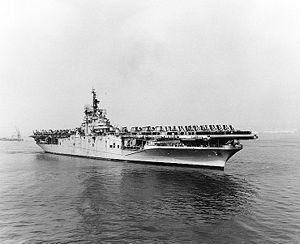
- 20 April — Ryūhō placed in reserve.
- 25 April — Incomplete Graf Zeppelin scuttled by Germany.
- 29 April — USS Coral Sea launched.
- 5 May — USS Kearsarge launched.
- 7 May — Nazi Germany surrenders.
- 8 May — USS Crown Point renamed , USS Coral Sea renamed .
- 12 May — USS Tarawa launched.
- 10 May — laid down.
- 3 June — USS Lake Champlain commissioned.
- 7 June — HMS Leviathan launched (ship never completed).
- 8 July — USS Princeton and USS Saipan launched.
- 24 July — Amagi heavily damaged during air raid.
- 25 July — Kaiyo, having been damaged in action the previous day, is deliberately grounded and later refloated.
- 28 July — Kaiyo further damaged in action, settles on bottom with 20-degree list to port.
- 29 July — Attempts to refloat Kaiyo abandoned.
- 29 July — Amagi capsized.
- 6 August — U.S. nuclear strike on HiroshimaAtomic bombings of Hiroshima and NagasakiDuring the final stages of World War II in 1945, the United States conducted two atomic bombings against the cities of Hiroshima and Nagasaki in Japan, the first on August 6, 1945, and the second on August 9, 1945. These two events are the only use of nuclear weapons in war to date.For six months...
. - 8 August — HMS Ocean commissioned.
- 9 August — Last of caretaker crew leave Kaiyo; U.S. nuclear strike on Nagasaki.
- 12 August — USS Reprisal canceled.
- 15 August — Japan surrenders WWII ends.
Post-war 1945–1949
1945_after_commissioning.jpg)

- USS Reprisal (incomplete) launched to clear slipway.
- 23 August — USS Leyte launched.
- 1 September — USS Wright launched.
- 5 September — USS Philippine Sea launched.
- 10 September — USS Midway commissioned.
- 22 September — HMS Hercules launched, laid up for possible future use.
- 13 October — USS Oriskany launched; Katsuragi assigned to repatriation duty.
- 19 October — HMS Edgar renamed and commissioned as .
- 27 October — USS Franklin D. Roosevelt commissioned.
- 18 November — USS Princeton commissioned.
- 20 November — Kaiyo decommissioned.
- 30 November — Junyō and Ryūhō decommissioned.
- 3 December — First landing by a jet-poweredJet engineA jet engine is a reaction engine that discharges a fast moving jet to generate thrust by jet propulsion and in accordance with Newton's laws of motion. This broad definition of jet engines includes turbojets, turbofans, rockets, ramjets, pulse jets...
aircraft on a carrier, . - 8 December — USS Tarawa commissioned.
1946
- Ryūhō sold for scrap.
- HMS Unicorn decommissioned and placed in reserve;
- January — HMS Audacious renamed .
- 9 February — HMS Theseus commissioned.
- March — Graf Zeppelin refloated by the Soviet Union, repaired, and designated "PO-101" (Floating Base Number 101).
- 2 March — USS Kearsarge commissioned.
- 14 Mar — HMS Warrior commissioned as HMCS Warrior.
- 19 March — HMS Eagle launched.
- April — Katsuragi placed on standby.
- 2 April — USS Coral Sea launched.
- 11 April — USS Leyte commissioned.

- 9 May — HMS Triumph commissioned.
- 11 May — USS Philippine Sea commissioned.
- 1 July — USS Independence and USS Saratoga used during a Bikini Atoll atomic testOperation CrossroadsOperation Crossroads was a series of nuclear weapon tests conducted by the United States at Bikini Atoll in mid-1946. It was the first test of a nuclear weapon after the Trinity nuclear test in July 1945...
; both ships were damaged, but survived the test. - 14 July — USS Saipan commissioned.
- 21 July — FH PhantomFH PhantomThe McDonnell FH Phantom was a twin-engined jet fighter aircraft designed and first flown during World War II for the United States Navy. The Phantom was the first purely jet-powered aircraft to land on an American aircraft carrier and the first jet deployed by the United States Marine Corps...
became the first purely jet-powered aircraft to operate from an American aircraft carrier. - 25 July — USS Saratoga sunk by an underwater atomic bomb test at Bikini Island.
- 6 August — HMS Colossus renamed Arromanches and loaned to France.
- 16 August — Hōshō decommissioned.
- 28 August — USS Independence decommissioned.
- September — First helicopter landing aboard a naval escort vessel at sea.
- 1 September — Hulk of Kaiyo sold for scrap.
- 18 October — USS Ranger decommissioned.
- 3 November — USS Valley Forge commissioned.
- 8 November — USS Bennington decommissioned, placed in reserve.
- 15 November — Katsuragi decommissioned.
- December — HMS Indefatigable decommissioned.
- December — HMS Argus sold for scrap.
- 19 December — First Indochina WarFirst Indochina WarThe First Indochina War was fought in French Indochina from December 19, 1946, until August 1, 1954, between the French Union's French Far East...
begins. - 22 December — Katsuragi sold for scrap.
1947
- HM Ships Indomitable & Formidable placed in reserve.
- HM Ships Majestic and Terrible purchased by Australia.
- Junyō sold for scrap.
- 9 January — USS Essex, USS Yorktown, USS Bon Homme Richard, USS Bunker Hill, and USS Ticonderoga decommissioned, placed in reserve.
- 13 January — USS Belleau Wood and USS Cowpens decommissioned, placed in reserve.
- 15 January — USS Hornet decommissioned, placed in reserve.
- 28 January — USS Ranger sold for scrap.

- 9 February — USS Wright commissioned.
- 11 February — USS Cabot, USS Monterey, USS Langley, and USS Bataan decommissioned, placed in reserve.
- 17 February — USS Lake Champlain, USS Enterprise, USS Franklin, and USS Wasp decommissioned, placed in reserve.
- 1 March — USS San Jacinto decommissioned, placed in reserve.
- 22 March — USS Intrepid decommissioned, placed in reserve.
- April — HMS Venerable decommissioned, placed in reserve.
- 22 April – HMS Centaur launched.
- 23 April — USS Lexington decommissioned, placed in reserve.
- 30 April — Hōshō sold for scrap.
- 6 May — HMS Albion launched.
- 9 May — USS Hancock decommissioned, placed in reserve.
- 16 August — Graf Zeppelin sunk in target practice by the Soviet Union.
- 12 August — USS Oriskany construction suspended.

- 1 October — USS Coral Sea commissioned.
- 7 November — USS Shangri-La decommissioned, placed in reserve.
1948
- January — HMS Furious sold for scrap.
- 25 February — USS Randolph decommissioned, placed in reserve.
- 21 March — HMS Magnificent loaned to Canada and commissioned as .
- 23 March — HMS Warrior returned to UK.
- May — HMS Venerable sold to Netherlands.
- 28 May — HMS Venerable recommissioned as HNLMS Karel DoormanHNLMS Karel Doorman (R81)HNLMS Karel Doorman was a Colossus-class aircraft carrier of the Royal Netherlands Navy. The ship was the British HMS Venerable before she was sold in 1948 to the Netherlands as a light attack carrier. In 1960 she was involved in the decolonization conflict in Western New Guinea with Indonesia...
. - 20 June — USS Princeton decommissioned, placed in reserve.
- 22 June — HMS Bulwark launched.
- 24 June — Soviet blockade of BerlinBerlinBerlin is the capital city of Germany and is one of the 16 states of Germany. With a population of 3.45 million people, Berlin is Germany's largest city. It is the second most populous city proper and the seventh most populous urban area in the European Union...
increased tensions in what would become the Cold WarCold WarThe Cold War was the continuing state from roughly 1946 to 1991 of political conflict, military tension, proxy wars, and economic competition between the Communist World—primarily the Soviet Union and its satellite states and allies—and the powers of the Western world, primarily the United States...
between NATO-allied nations and the Warsaw PactWarsaw PactThe Warsaw Treaty Organization of Friendship, Cooperation, and Mutual Assistance , or more commonly referred to as the Warsaw Pact, was a mutual defense treaty subscribed to by eight communist states in Eastern Europe...
. - 27 October — USS Cabot recommissioned.
- November — HMS Warrior recommissioned, fitted with a rubber deck for trials.
- 16 December — HMS Terrible commissioned as .

- HMS Unicorn recommissioned as transport carrier.
- Dixmude converted for use as a transport.
- 18 April — laid down.
- 4 April — NATO alliance formed.
- 23 April — USS United States cancelled.
- 21 June — USS Antietam decommissioned, placed in reserve.
- 30 June — USS Tarawa decommissioned, placed in reserve.
- 2 August — USS Reprisal (incomplete) sold for scrap.
1950–1959
1950- HMS Indomitable recommissioned; HMS Indefatigable recommissioned as a training ship.
- 3 May — HMS Ark Royal launched.
- 13 May — USS Bataan recommissioned.
- June — USS Oriskany construction resumed.
- 16 June — USS Kearsarge decommissioned, taken in hand for modernisation.
- 25 June — Korean WarKorean WarThe Korean War was a conventional war between South Korea, supported by the United Nations, and North Korea, supported by the People's Republic of China , with military material aid from the Soviet Union...
begins. - 28 August — USS Princeton recommissioned.
- 15 September — USS Monterey recommissioned.
- 25 September — USS Oriskany commissioned.
1951

- Aquila sold for scrap
- Aromanches purchased by France.
- January — USS Langley loaned to France.
- 15 January — USS Bon Homme Richard recommissioned.
- 16 January — USS Essex recommissioned.
- 17 January — USS Antietam recommissioned.
- 29 January — USS Independence sunk in weapons tests.
- 3 February — USS Tarawa recommissioned.
- 20 March — USS Hornet recommissioned.
- 10 May — USS Shangri-La recommissioned.
- 12 May — USS Hornet decommissioned for conversion to CVA.
- 6 June — USS Langley recommissioned as La FayetteLa Fayette (R96)The La Fayette was an 11,000-ton that served French Navy as the from 1951 to 1963. She was the first French vessel named after the 18th century general Marquis de Lafayette...
. - July — First trials of a steam catapult, on .
- 31 July — HMS VidalHMS Vidal-Construction and naming:Vidal was built at Chatham Dockyard, and was the last surface vessel, and the last oceanographic survey vessel built at the Dockyard. She was also the first small ship designed to carry a helicopter. She was launched on 31 July 1951 and commissioned into service in 1954...
launched, first small ship designed to carry a helicoptes.— - 10 September — USS Wasp recommissioned as CVA.
- 1 October — HMS Eagle commissioned.
1952
- First trial of angled flight deck, on .
- First trial of mirror landing aid, on .
- 9 February — USS Intrepid recommissioned.
- 15 February — USS Kearsarge recommissioned.
- 31 January — USS Ticonderoga recommissioned.
- 4 April — USS Ticonderoga decommissioned for conversion to CVA.
- 9 April — USS Intrepid decommissioned for conversion to CVA.
- 23 April — HMS Powerful sold to Canada, work recommenced.
- 14 July — laid down.
- 19 September — USS Lake Champlain recommissioned.
- October — USS Boxer reclassified CVA.
- 13 November — HMS Vengeance loaned to Australia, recommissioned as HMAS Vengeance; USS Bennington recommissioned as CVA.
- 14 November — USS Shangri-La decommissioned for modernisation.
- 16 December — laid down.
1953
- HMS Formidable sold for scrap.
- HMS Unicorn decommissioned, placed in reserve.
- 16 February — HMS Hermes launched.
- 20 February — USS Yorktown recommissioned.
- May — HMS Indomitable sold for scrap.
- 15 May — USS Bon Homme Richard decommissioned, commenced extensive refit.
- 1 July — USS Randolph recommissioned.
- 27 July — Korean War fighting ends with the Korean armistice agreement.
- 1 September – HMS Centaur launched.
- 5 September — USS Belleau Wood loaned to France.
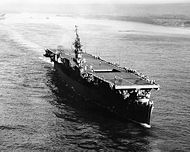
- 5 September — USS Belleau Wood recommissioned as Bois Belleau.
- 11 September — USS Hornet recommissioned.
1954
- HMS Perseus decommissioned, placed in reserve.
- Mid 1954 — HM Ships Implacable & Indefatigabledecommissioned.
- 15 February — USS Hancock recommissioned as CVA.
- 9 April — USS Bataan decommissioned, placed in reserve.
- 23 April – USS Franklin D Roosevelt decommissioned for modernisation.
- 26 May — HMS Albion commissioned.
- 18 June — USS Intrepid recommissioned in reserve.
- 1 August — First Indochina War ends.
- 2 August — laid down.
- September — HMS Pioneer decommissioned and sold for scrap;
- 11 September — USS Ticonderoga recommissioned after modernisation.

- 15 October — USS Intrepid returned to full commission.
- 4 November — HMS Bulwark commissioned.
- December — HMS Illustrious decommissioned.
- 11 December — USS Forrestal launched.
1955
- 10 January — USS Shangri-La recommissioned.
- 21 January — USS Cabot decommissioned, placed in reserve.
- 25 February — HMS Ark Royal commissioned.
- 6 April – USS Franklin D Roosevelt recommissioned with angled flight deck, steam catapult and hurrican bow.
- 14 May — Warsaw Pact formed.
- July — USS Midway decommissioned for modernisation.
- 1 July — laid down.
- 13 August — HMS Vengeance returned to UK.
- 15 August — USS Lexington recommissioned as CVA.
- 6 September — USS Bon Homme Richard recommissioned.
- 29 September — USS Forrestal commissioned.
- 8 October — USS Saratoga launched.
- 25 October — HMAS Vengeance decommissioned.
- 26 October — HMS Majestic christened as HMAS Majestic.
_1956_(awm_301019).jpg)
- 28 October — HMAS Majestic renamed and commissioned as ; HMS Vengeance recommissioned in reserve.
- November – HMS Implacable sold for scrap.
- 1 November — ClemenceauClemenceau (R 98)Clemenceau , often affectionately called "le Clem'", was the lead ship of her class, and the 6th aircraft carrier of the French Navy, serving from 1961 to 1997. She was the second French warship to be named after Georges Clemenceau, the first one being a battleship of the Richelieu class, laid...
(France) laid down. - 15 November — USS Boxer reclassified as CVS.
1956
- HMS Indefatigable sold for scrap.
- HMS Glory decommissioned, placed in reserve.
- 16 January — USS Monterey decommissioned, placed in reserve.
- 15 March — USS Wright decommissioned, placed in reserve.
- 13 April — USS Hancock decommissioned.
- 14 April — USS Saratoga commissioned.
- 26 September — USS Ranger launched.
- 29 October — Suez CrisisSuez CrisisThe Suez Crisis, also referred to as the Tripartite Aggression, Suez War was an offensive war fought by France, the United Kingdom, and Israel against Egypt beginning on 29 October 1956. Less than a day after Israel invaded Egypt, Britain and France issued a joint ultimatum to Egypt and Israel,...
begins. - 3 November — HMS Illustrious sold for scrap.
- 15 November — USS Hancock recommissioned.
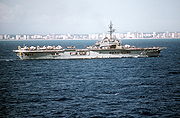
- 14 December — HMS Vengeance sold to Brazil.
- 27 December — laid down.
1957
- HMS Theseus decommissioned, placed in reserve.
- January — HMS Hercules sold to India, construction restarted.
- 2 January — USS Oriskany decommissioned, started modernisation.
- 17 January — HMS Powerful commissioned as .
- 15 February — FochFoch (R 99)Foch was the second of the French Navy. She was the second warship named in honour of Marshal Ferdinand Foch, after a heavy cruiser commissioned in 1932, and scuttled in Toulon on 27 November 1942....
(France) laid down. - 24 May — USS Coral Sea decommissioned for modernisation.
- 14 June — HMCS Magnificent returned to UK and placed in reserve as HMS Magnificent.
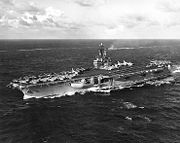
- 10 August — USS Ranger commissioned.
- 14 September — laid down.
- 30 September — USS Midway recommissioned.
- 3 October — USS Saipan decommissioned, placed in reserve.
- 5 December — HMS Ocean decommissioned, placed in reserve.
- 21 December — Clemenceau launched.
1958
- HM Ships Perseus & Ocean sold for scrap.
- February — HMS Warrior decommissioned.
- 4 February — laid down.
- 30 May — HMAS Sydney decommissioned, held in reserve.
- 6 June — USS Independence launched.
- 1 July — USS Enterprise (Yorktown class) sold for scrap.
- 4 November — Ex HMS Warrior sold to Argentina.
- 28 December — USS Philippine Sea decommissioned, placed in reserve.
1959

- 10 January — USS Independence commissioned.
- 26 January — Ex HMS Warrior commissioned as ARA Independencia.
- 30 January — USS Boxer reclassified LPH.
- 2 March — USS Princeton reclassified LPH.
- 7 March — USS Oriskany recommissioned.
- 15 May — USS Leyte decommissioned, placed in reserve.
- June — HMS Unicorn sold for scrap.
- 1 November — USS Cowpens sold for scrap.
- 18 November — HMS Hermes commissioned.
1960–1969
1960_underway_bow_view.jpg)
- Dixmude hulked as an accommodation ship.
- HM Ships Ocean and Theseus sold for scrap.
- 25 January — USS Coral Sea recommissioned.
- May — USS Tarawa decommissioned, placed in reserve.
- 21 May — USS Kitty Hawk launched.
- 28 July — Foch launched.
- September — Bois Belleau returned to USN.
- 24 September — USS Enterprise launched.
- 1 October — Bois Belleau struck.
- 8 October — USS Constellation launched.
- 21 November — USS Belleau Wood sold for scrap.
- 6 December — ex HMS Vengeance recommissioned as NAeL Minas GeraisNAeL Minas GeraisNAeL Minas Gerais was a operated by the Marinha do Brasil from 1960 until 2001. The ship was laid down for the Royal Navy during World War II as , but was completed only shortly before the war's end, and did not see service...
.
1961
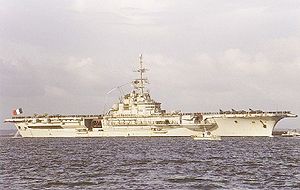
- 9 January — laid down.
- 4 March — HMS Hercules commissioned as INS VikrantINS VikrantINS Vikrant was a Majestic-class light aircraft carrier of the Indian Navy.Her keel was laid down on 12 November 1943 by Vickers-Armstrong on the Tyne and she was launched on 22 September 1945....
. - 29 April — USS Kitty Hawk commissioned.
- May — USS Bataan sold for scrap.
- 1 July — USS Valley Forge reclassified LPH.
- 27 October — USS Constellation commissioned.
- 22 November — Clemenceau commissioned.
- 25 November — USS Enterprise commissioned; first nuclear-poweredNuclear marine propulsionNuclear marine propulsion is propulsion of a ship by a nuclear reactor. Naval nuclear propulsion is propulsion that specifically refers to naval warships...
aircraft carrier.

- 7 March — HMAS Sydney recommissioned as fast troop carrier.
- 15 March — USS Wright conversion to command and controlCommand and Control (military)Command and control, or C2, in a military organization can be defined as the exercise of authority and direction by a properly designated commanding officer over assigned and attached forces in the accomplishment of the mission...
ship started. - Mid 1962 – HMS Albion designated as commando carrier.
- August — Indonesia plans invasion of West New Guinea; war plans include sinking of Dutch carrier Karel DoormanHNLMS Karel Doorman (R81)HNLMS Karel Doorman was a Colossus-class aircraft carrier of the Royal Netherlands Navy. The ship was the British HMS Venerable before she was sold in 1948 to the Netherlands as a light attack carrier. In 1960 she was involved in the decolonization conflict in Western New Guinea with Indonesia...
using Soviet-supplied bomberBomberA bomber is a military aircraft designed to attack ground and sea targets, by dropping bombs on them, or – in recent years – by launching cruise missiles at them.-Classifications of bombers:...
s with anti-ship missileAnti-ship missileAnti-ship missiles are guided missiles that are designed for use against ships and large boats. Most anti-ship missiles are of the sea-skimming type, many use a combination of inertial guidance and radar homing...
s, but ceasefire ended the threat.
1963
- 7 January — USS Antietam decommissioned, placed in reserve.
- 8 February — Short Take Off and Vertical LandingSTOVLSTOVL is an acronym for short take off and vertical landing.This is the ability of some aircraft to take off from a short runway or take off vertically if it does not have a very heavy payload and land vertically...
(STOVL) test aircraft and pre-HarrierHarrier Jump JetThe Harrier, informally referred to as the Jump Jet, is a family of British-designed military jet aircraft capable of vertical/short takeoff and landing operations...
prototype Hawker P.1127Hawker P.1127The Hawker P.1127 and the Hawker Siddeley Kestrel FGA.1 were the experimental and development aircraft that led to the Hawker Siddeley Harrier, the first vertical and/or short take-off and landing jet fighter-bomber...
first operates from . - 15 July — Foch commissioned.
- March — La Fayette (USS Langley) returned to USN.
- March — USS Saipan conversion to communications command ship started.
- 11 May — USS Wright recommissioned as command and control ship.
1964
- 19 February – USS Langley sold for scrap.
- 1 February — USS America launched.
- 2 August — Gulf of Tonkin IncidentGulf of Tonkin IncidentThe Gulf of Tonkin Incident, or the USS Maddox Incident, are the names given to two incidents, one fabricated, involving North Vietnam and the United States in the waters of the Gulf of Tonkin...
led U.S. to greatly increase its overt role in the Vietnam WarVietnam WarThe Vietnam War was a Cold War-era military conflict that occurred in Vietnam, Laos, and Cambodia from 1 November 1955 to the fall of Saigon on 30 April 1975. This war followed the First Indochina War and was fought between North Vietnam, supported by its communist allies, and the government of...
. - 1 September — USS Saipan reclassified as Major Communications Relay Ship (AGMR).
- 22 October — laid down.
1965

- 23 January — USS America commissioned.
- 8 April — USS Saipan renamed .
- July — HMS Magnificent sold for scrap.
1966
- HMS Centaur designated as depot ship.
- Béarn decommissioned.
- British 1966 Defence White Paper1966 Defence White PaperThe 1966 Defence White Paper was a major review of the United Kingdom's defence policy brought about by the Labour Party government under the Prime Minister Harold Wilson. The main author was the then Secretary of State for Defence, Denis Healey...
cancels defense projects such as CVA-01CVA-01The CVA-01 aircraft carrier was to be a class of at least two fleet carriers that would have replaced the Royal Navy's existing aircraft carriers, most of which had been designed prior to or during World War II....
and begins plans for phased end to UK carrier aviation. - Dixmude returned to U.S. Navy, sunk as target.
- 15 February — USS Midway decommissioned for further modernisation.
- 2 May — USS Lake Champlain decommissioned.
- 27 July — USS Franklin sold for scrap.
- 27 August — USS Arlington recommissioned as communication relay ship.
1967

- HMS Victorious decommissioned for re-fit, subsequently damaged in a minor fire leading to decision to scrap.
- 30 August — USS Cabot loaned to Spain, recommissioned as DédaloSpanish aircraft carrier DédaloDédalo was the first Spanish aircraft carrier and the second aviation ship in the Spanish Navy . She remained the fleet's flagship until the Principe de Asturias replaced her...
. - 31 March — Béarn sold for scrap.
- 27 May — USS John F. Kennedy launched.
1968
- Arromanches redesignated as a helicopter carrierHelicopter carrierHelicopter carrier is a term for an aircraft carrier whose primary purpose is to operate helicopters. The term is sometimes used for both ASW carriers and amphibious assault ships....
. - 26 April — HNLMS Karel Doorman decommissioned, placed in reserve, end of Dutch carrier aviation.
- 22 June — laid down
- July — USS Franklin D. Roosevelt decommissioned for modernisation.
- 7 September — USS John F. Kennedy commissioned.
- 3 October — USS Tarawa sold for scrap.
- 15 October — HNLMS Karel Doorman sold to Argentina.
1969
- 1 January — USS Lexington reclassified as a training carrier (CVT).
- 13 February — USS Randolph decommissioned, placed in reserve.
- 12 March — ex HNLMS Karel Doorman recommissioned as ARA Veinticinco de MayoARA Veinticinco de Mayo (V-2)The ARA Veinticinco de Mayo was an aircraft carrier in the Argentine Navy from 1969 to 1997. The English translation of the name is the Twenty-fifth of May, which is the date of Argentina's May Revolution in 1810....
. - 26 May — USS Franklin D. Roosevelt recommissioned.
- 30 June — USS Essex decommissioned.
- July – HMS Victorious sold for scrap.
- 1 December — USS Boxer decommissioned; USS Philippine Sea struck.
1970–1979
1970- ARA Independencia decommissioned, placed in reserve.
- 14 January — USS Arlington decommissioned.
- 15 January — USS Bennington decommissioned, placed in reserve; USS Valley Forge decommissioned.
- 30 January — USS Princeton decommissioned.
- 31 January — USS Midway recommissioned.
- 13 February — USS Kearsarge decommissioned, placed in reserve.
- 27 May — USS Wright decommissioned, placed in reserve.
- 26 June — USS Hornet decommissioned, placed in reserve.
- 27 June — USS Yorktown decommissioned.
- 3 July — HMCS Bonaventure decommissioned.
- 15 August — laid down.
- September — Soviet aircraft carrier KievSoviet aircraft carrier KievKiev was a heavy aircraft carrying cruiser that served the Soviet and Russian navies from 1975 to 1993. It was built from 1970 till 1975 at Chernomorski factory in Nikolayev and was the first ship of its class -Service life:The Kiev was laid down on 21 July 1970 and launched on 26 December 1972...
laid down. - September — USS Leyte sold for scrap.
1971
- HMS Centaur decommissioned.
- March — HMCS Bonaventure sold for scrap.
- 13 March — USS Boxer sold for scrap.
- 17 March — ARA Independencia sold for scrap.
- 23 March — USS Philippine Sea sold for scrap.
- May — USS Monterey and USS Princeton sold for scrap.
- 2 July — USS Bon Homme Richard decommissioned, placed in reserve.
- 30 July — USS Shangri-La decommissioned, placed in reserve.
- 29 October — USS Valley Forge sold for scrap.
- 3 December — Indo-Pakistani War of 1971Indo-Pakistani War of 1971The Indo-Pakistani War of 1971 was a military conflict between India and Pakistan. Indian, Bangladeshi and international sources consider the beginning of the war to be Operation Chengiz Khan, Pakistan's December 3, 1971 pre-emptive strike on 11 Indian airbases...
begins. Indian carrier INS VikrantINS VikrantINS Vikrant was a Majestic-class light aircraft carrier of the Indian Navy.Her keel was laid down on 12 November 1943 by Vickers-Armstrong on the Tyne and she was launched on 22 September 1945....
carries out airstrikes against land and naval targets; Pakistani submarine PNS GhaziPNS GhaziPNS Ghazi was Pakistan Navy 's first ever submarine, leased from United States in 1963. It saw action in the 1965 and 1971 wars between India and Pakistan. The submarine could be armed with up to 28 torpedoes and, in later years, was re-fitted in Turkey for mine-laying capability...
sent to hunt the Vikrant, but sinks under mysterious circumstances. - 15 December — USS San Jacinto sold for scrap.
1972
_underway.jpg)
- HMS Centaur sold for scrap.
- HMS Albion decommissioned and sold for scrap.
- 26 January — HMS Eagle decommissioned.
- 28 April — USS Lake Champlain sold for scrap.
- 13 May — USS Nimitz launched.
- 1 July — USS Wasp decommissioned.
- 5 December — Loan of Dédalo (ex ) to Spain converted to sale.
- December — Kiev launched, MinskSoviet aircraft carrier MinskMinsk is an aircraft carrier that served the Soviet Navy, and later the Russian Navy, from 1978 to 1994. She was the second Kiev-class vessel to be built.- History :...
laid down.
1973
- USS Bunker Hill sold for scrap.
- 27 January — Paris Peace AccordsParis Peace AccordsThe Paris Peace Accords of 1973 intended to establish peace in Vietnam and an end to the Vietnam War, ended direct U.S. military involvement, and temporarily stopped the fighting between North and South Vietnam...
; U.S. forces withdraw from the Vietnam War. - 21 May — USS Wasp sold for scrap.
- 20 July — laid down.
- 1 September — USS Ticonderoga decommissioned.
- 12 November — HMAS Sydney decommissioned.
1974
- 22 January — Arromanches decommissioned.
- 28 February — USS Antietam sold for scrap.
- 1 March — USS Kearsarge sold for scrap.
- 15 March — USS Intrepid decommissioned.
1975
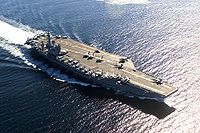
- HMS Triumph decommissioned, placed in reserve.
- 1 April — USS Randolph sold for scrap.
- May — Kiev commissioned.
- 3 May — USS Nimitz commissioned.
- 1 June — USS Essex sold for scrap.
- 1 September — USS Ticonderoga sold for scrap.
- 30 September — Minsk launched; NovorossiyskSoviet aircraft carrier NovorossiyskNovorossiysk was a conventionally powered heavy aircraft carrying cruiser or aircraft carrier that served the Soviet Navy, and later the Russian Navy, from 1982 to 1993. She was the third Kiev class vessel to be built...
laid down. - 11 October — USS Dwight D. Eisenhower launched; laid down.
- 13 October — USS Yorktown preserved as museum ship.
- 28 October — HMAS Sydney sold for scrap.
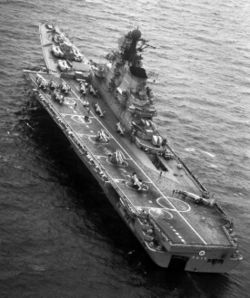
- 30 January — USS Hancock decommissioned.
- March — HMS Bulwark decommissioned, placed in reserve.
- 1 June — USS Arlington sold for scrap.
- 1 September — USS Hancock sold for scrap.
- September STOVL Harriers equip Spanish aircraft carrier DédaloSpanish aircraft carrier DédaloDédalo was the first Spanish aircraft carrier and the second aviation ship in the Spanish Navy . She remained the fleet's flagship until the Principe de Asturias replaced her...
, returning her to fixed-wing carrier operations; first STOVL aircraft carrier. - 30 September — USS Oriskany decommissioned, placed in reserve.
- 7 October — laid down.
1977
- 3 May — HMS Invincible launched.
- 30 September — USS Franklin D. Roosevelt decommissioned.
- 18 October — USS Dwight D. Eisenhower commissioned.
1978
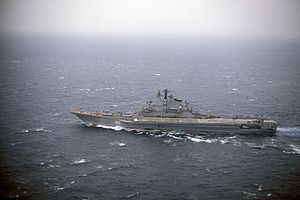
- Arromanches sold for scrap.
- 1 April — USS Franklin D. Roosevelt sold for scrap.
- 27 September — Minsk commissioned.
- 17 February — Baku laid down.
- October — HMS Eagle sold for scrap.
- 1 December — HMS Illustrious launched.
- 14 December — (Invincible class) laid down.
- 26 December — Novorossiysk launched.
1979
- February — HMS Ark Royal (Audacious class) decommissioned; end of conventional Catapult-Assisted Take-Off But Arrested RecoveryCATOBARCATOBAR is a system used for the launch and recovery of aircraft from the deck of an aircraft carrier...
(CATOBAR) carrier operations for the UK. - 23 February — HMS Bulwark recommissioned.
- 8 October — Principe de Asturias laid down.
1980–1989
1980.jpg)
- HMS Bulwark placed in reserve.
- 15 March — USS Carl Vinson launched.
- 11 July — HMS Invincible commissioned; first purpose-built STOVL carrier, first ship to include a ski-jump ramp.
- 1 August — USS Wright sold for scrap.
- 22 September — HMS Ark Royal (Audacious class) sold for scrap.
1981
- 26 March — Giuseppe Garibaldi laid down.
- 27 March — HMS Bulwark decommissioned.
- 10 April — HMS Bulwark sold for scrap.
- 9 May — First carrier fitted with a ski jump, .
- 2 June — HMS Ark Royal launched.
- 13 October — laid down.
- 9 December — HMS Triumph sold for scrap.
1982

- 25 February — Australian government announces its intention to purchase HMS Invincible and rename it HMAS Australia.
- 13 March — USS Carl Vinson commissioned.
- 19 March — Argentina invades South Georgia, launching the Falklands WarFalklands WarThe Falklands War , also called the Falklands Conflict or Falklands Crisis, was fought in 1982 between Argentina and the United Kingdom over the disputed Falkland Islands and South Georgia and the South Sandwich Islands...
; this war provides the impetus to slow the drawdown of the Royal Navy, including carrier aviation; deal to sell the HMS Invincible to Australia cancelled. - 23 March — USS Intrepid struck, preserved as a museum ship.
- 1 April — Baku launched.
- 1 May — Argentine carrier ARA Veinticinco de MayoARA Veinticinco de MayoARA Veinticinco de Mayo may refer to the following specific vessels of the Argentine Navy* Cruiser ARA Veinticinco de Mayo, 1891-1916* Cruiser ARA Veinticinco de Mayo , 1931-1960* Aircraft carrier ARA Veinticinco de Mayo , 1969-1997...
detects and attempts airstrike against British fleet, but is unable to launch due to unfavorable winds. - 2 May — Argentine cruiser ARA General BelgranoARA General BelgranoThe ARA General Belgrano was an Argentine Navy light cruiser in service from 1951 until 1982. Formerly the , she saw action in the Pacific theater of World War II before being sold to Argentina. After almost 31 years of service, she was sunk during the Falklands War by the Royal Navy submarine ...
sunk by British submarine; carrier Veinticinco de Mayo withdraws to safe port for the duration of the war. - 22 May — Principe de Asturias launched.
- 30 May — HMAS Melbourne decommissioned.
- 14 June — Argentine land forces in the Falkland Islands surrender, ending the conflict.
- 20 June — HMS Illustrious commissioned.
- 5 July — USS Shangri-La struck.
- September — Novorossiysk commissioned.
1983
- 22 February — Leonid Brezhnev laid down.
- 4 June — Giuseppe Garibaldi launched.
1984
- 12 April — HMS Hermes decommissioned, placed in maintained reserve.
- 27 October — USS Theodore Roosevelt launched.
- 3 November — laid down.
1985
- ARA Veinticinco de Mayo inoperable, laid up for possible modernisation.
- HMAS Melbourne sold for scrap.
- 30 September — Giuseppe Garibaldi commissioned as helicopter anti-submarine warfare carrierAnti-submarine warfare carrierAn ASW carrier is a type of small aircraft carrier whose primary role is to hunt and destroy submarines...
. - 1 November — HMS Ark Royal commissioned.
- 5 December — Leonid Brezhnev launched.
- 10 December — Riga laid down.
1986
- April — HMS Hermes sold to India.
- 15 April — U.S. 1986 Bombing of Libya by carrier- and land-based aircraft.
- 25 August — laid down.
- 25 October — USS Theodore Roosevelt commissioned.
_during_dragon_hammer_92.jpg)
- 11 December — Baku commissioned.
1988
- 13 February — USS Abraham Lincoln launched.
- 30 May — Principe de Asturias commissioned.
- 9 August — USS Shangri-La sold for scrap.
- October — Leonid Brezhnev renamed Tbilisi.
- December — UlyanovskSoviet aircraft carrier UlyanovskUlyanovsk was the first of a class of Soviet nuclear-powered supercarriers which for the first time would have offered true blue water aviation capability for the Soviet Navy...
laid down. - 4 December — Riga launched.
1989
_malabar_07.jpg)
- Giuseppe Garibaldi takes on Harrier aircraft, initiating Italian fixed-wing carrier operations.
- INS Vikrant ends CATOBAR operations and is converted with ski jump to all-STOVL operations.
- 14 April — Charles de Gaulle laid down; first non-U.S. nuclear aircraft carrier.
- 20 May — Ex HMS Hermes commissioned as INS Viraat.
- 25 July — USS Hornet struck, preserved as a museum ship; USS Oriskany struck to be preserved as a museum ship or scrapped.
- 5 August — Dédalo decommissioned.
- 20 September — U.S. Ships Bon Homme Richard and Bennington struck.
- 11 November — USS Abraham Lincoln commissioned.
1990–1999
1990- Riga renamed VaryagSoviet aircraft carrier VaryagVaryag was to be an Admiral Kuznetsov class multirole aircraft carrier of the Soviet Union. She was known as Riga when her keel was laid down at Shipyard 444 in Nikolayev December 6, 1985. Design of the carrier was undertaken by the Nevskoye Planning and Design Bureau...
. - 30 April — USS Coral Sea decommissioned.
- 21 July — USS George Washington launched.
- 2 August — Gulf WarGulf WarThe Persian Gulf War , commonly referred to as simply the Gulf War, was a war waged by a U.N.-authorized coalition force from 34 nations led by the United States, against Iraq in response to Iraq's invasion and annexation of Kuwait.The war is also known under other names, such as the First Gulf...
begins with Iraq invading Kuwait. - 4 October — Tbilisi renamed Admiral Kuznetsov.
1991

- Baku renamed Admiral GorshkovSoviet aircraft carrier Admiral GorshkovAdmiral Gorshkov was a modified Kiev class aircraft carrier of the Russian Navy, originally named Baku. Sometimes Gorshkov is considered a separate class due to its improvements including a phased array radar, extensive electronic warfare installations, and an enlarged command and control suite...
. - 21 January — Admiral Kuznetsov commissioned.
- 28 February — Gulf War ends with ceasefire.
- 13 March — laid down.
- 1 November — Ulyanovsk cancelled at 40% complete.
- 8 November — USS Lexington decommissioned.
- 25 December — Soviet Union dissolves, Cold WarTimeline of events in the Cold War-1945:*February 4: The Yalta Conference occurs, deciding the post-war status of Germany. The Allies of World War II divide Germany into four occupation zones. The Allied nations agree that free elections are to be held in all countries occupied by Nazi Germany...
ends.
1992
- Construction of Varyag stopped, transferred to the Ukraine.
- 4 February — Ulyanovsk scrapped; USS Bon Homme Richard sold for scrap.
- 11 April — USS Midway decommissioned, preserved as a museum ship.
- 15 June — USS Lexington donated as a museum ship.
- 4 July — USS George Washington commissioned.
- September — Novorossiysk laid up in reserve.

- 7 May — USS Coral Sea sold for scrap.
- 30 June — Kiev, Minsk and Novorossiysk decommissioned.
- 10 July — USS Ranger decommissioned, on donation hold as of 2004.
- 11 September — USS Forrestal decommissioned, on donation hold.
- 13 November — USS John C. Stennis launched.
- 29 November — laid down.
1994
- 1 December — USS Bennington sold for scrap.
- 7 May — Charles de Gaulle launched.
- 12 July — HTMS Chakri Naruebet laid down.
- 20 August — USS Saratoga decommissioned.
1995
__hms_illustrious_(r_06).jpg)
- 1 August — Novorossiysk and Minsk sold for scrap, Minsk not scrapped.
- 9 September — USS Oriskany sold for scrap, not scrapped.
- 9 December — USS John C. Stennis commissioned.
1996
- 20 January — HTMS Chakri Naruebet launched.
- 9 August — USS America decommissioned.
- 14 September — USS Harry S. Truman launched.
1997

- ARA Veinticinco de Mayo decommissioned.
- 31 January — INS Vikrant decommissioned, to be converted to a museum ship at Mumbai.
- 27 March — HTMS Chakri Naruebet commissioned.
- 30 July — USS Oriskany repossessed by the USN due to default by scrapping contractor.
- 1 October — Clemenceau decommissioned.
1998
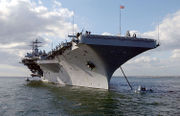
- 12 February — laid down.
- April — Varyag sold to China.
- August — Minsk towed to China for use in an amusement park.
- 30 September — USS Independence decommissioned.
- 25 July — USS Harry S. Truman commissioned.
1999
- January — ARA Veinticinco de Mayo sold for scrap.
2000–2009
2000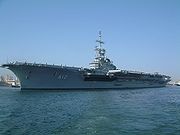
- 1 January — USS Saratoga placed on donation hold.
- October — Scrapping of Dédalo commenced.
- 15 November — Foch decommissioned, and recommissioned as NAe São Paulo.
2001
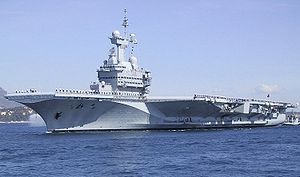
- 10 March — USS Ronald Reagan launched.
- 18 May — Charles de Gaulle commissioned.
- 17 July — Cavour laid down.
- 7 October — War in AfghanistanWar in Afghanistan (2001–present)The War in Afghanistan began on October 7, 2001, as the armed forces of the United States of America, the United Kingdom, Australia, and the Afghan United Front launched Operation Enduring Freedom...
begins. - 16 October — NAeL Minas Gerais decommissioned.
2003
- 20 March — US-led 2003 invasion of Iraq launched.
- 12 July — USS Ronald Reagan commissioned.
- 7 August — USS Constellation decommissioned.
- 6 September — laid down.
- 11 September — USS Forrestal designated for disposal.
- 2 December — USS Constellation striken.
2004
- NAeL Minas Gerais sold for scrap.
- 20 January — Admiral Gorshkov sold to India; being refurbished and renamed INS VikramadityaINS VikramadityaINS Vikramaditya is the new name for the former Soviet aircraft carrier Admiral Gorshkov, which has been procured by India, and is estimated to enter service in the Indian Navy after 2012....
. - April — USS Independence nominated to be sunk as artificial reef.
- 20 July — Cavour launched.
2005
- 11 April — INS Vikrant steel plate cutting started.
- 19 April — USS America towed to sea for live firing tests.
- May — Juan Carlos I laid down.
- 14 May — USS America scuttled.
- 3 August — HMS Invincible decommissioned, placed in reserve until 2010.
2006
- 17 May — USS Oriskany sunk as an artificial reef.
- 31 May — Minsk sold at auction, disposition unknown.
- 7 October — USS George H. W. Bush launched.
2007
- 1 August — USS John F. Kennedy decommissioned, placed in reserve.
2008
- February — USS Forrestal prepared to be sunk as a reef; USS Independence and USS Constellation scheduled to be scrapped within five years.
- 10 March — Juan Carlos I launched.
- 27 March — Cavour commissioned.
2009
- 10 January — USS George H. W. Bush commissioned; final ship of the Nimitz class.
- 28 February — INS Vikrant keel laid
- 12 May — USS Kitty Hawk decommissioned, placed in reserve.
- 7 July — First steel cut for
2010–present
2010- 30 September — Juan Carlos I commissioned
- October 2010 — UK government decides to construct HMS Queen Elizabeth with catapults and arresting gear
2011
- 11 Mar — HMS Ark Royal decommissioned
- 26 May — First steel cut for HMS Prince of Wales
- 10 August — The Chinese People's Liberation Army NavyPeople's Liberation Army NavyThe People's Liberation Army Navy is the naval branch of the People's Liberation Army , the military of the People's Republic of China. Until the early 1990s, the navy performed a subordinate role to the PLA Land Forces. Since then, it has undergone rapid modernisation...
's first aircraft carrier, the ex-VaryagSoviet aircraft carrier VaryagVaryag was to be an Admiral Kuznetsov class multirole aircraft carrier of the Soviet Union. She was known as Riga when her keel was laid down at Shipyard 444 in Nikolayev December 6, 1985. Design of the carrier was undertaken by the Nevskoye Planning and Design Bureau...
completed, and began undergoing sea trials.
Footnotes
For most carriers, the dates listed here are those when the carrier was laid down, launched, commissioned, decommissioned and disposed of. If the carrier was a conversion from another ship, then the first date listed is when she was taken in hand to be converted; however, if a carrier was subsequently redesignated, its history is followed until disposal. The first time a ship is named in the list, it is linked to the relevant page within Wikipedia; if the ship was renamed, the first instance of the new name is also linked. Additionally, key relevant historical dates are interspersed with the ship-related dates to provide context.For the purposes of this timeline, an aircraft carrier is a commissioned naval ship with at least one permanent flush deck designed for the launch and recovery of fixed-wing aircraft. This timeline does not include ships with temporary landing or take-off platforms, vessels designed for helicopter operations, marine assault ships of various designs, catapult ships, WWII escort carriers, merchant aircraft carrier
Merchant aircraft carrier
Merchant aircraft carriers were bulk cargo ships with minimal aircraft handling facilities, used during World War II by Britain and the Netherlands as an interim measure to supplement British and United States-built escort carriers in providing an anti-submarine function for convoys...
s, CAM ship
CAM ship
CAM ships were World War II-era British merchant ships used in convoys as an emergency stop-gap until sufficient escort carriers became available. CAM is an acronym for catapult aircraft merchantman. A CAM ship was equipped with a rocket-propelled catapult launching a single Hawker Sea Hurricane,...
s, nor seaplane
Seaplane
A seaplane is a fixed-wing aircraft capable of taking off and landing on water. Seaplanes that can also take off and land on airfields are a subclass called amphibian aircraft...
carriers and tenders.
The timeline is mainly divided into decades, the exceptions being the two World Wars and the interwar period, which are each treated as separate blocks. For the purposes of this list, the First World War is considered to have started on 28 June 1914 and ended 11 November 1918, while the Second World War is considered to have started on 1 September 1939 and ended 14 August 1945.
The actual text of the message from the First Lord of the Admiralty to the Wright Brothers, dated 7 March 1907, taken from The Old Flying Days by Charles Cyril Turner, p. 293, was:
Web Sites
- Individual ship entries:-
- Langley (CV-1)
- Indiana (BB-1)
- Lexington (CV-2)
- Saratoga (CV-3)
- Yorktown (CV-5)
- Wasp (CV-7)
- Enterprise (CV-6)
- Hornet (CV-8)
- Lexington (CV-16) laid down as Cabot
- Yorktown (CV-10) laid down as Bon Homme Richard
- Intrepid (CV-11)
- Princeton (CVL-23) laid down as Tallahassee
- Belleau Wood (CVL-24) laid down as New Haven
- "CV FOCH (R 99)", "CV CLEMENCEAU (R 98)", Carriers, French Fleet Air Arm, Retrieved 24 September 2008
- "HMAS Melbourne (II)", "HMAS Sydney (III)", HMAS Vengeance", HMA Ship Histories, Sea Power Centre, Royal Australian Navy official web site, Retrieved 13 September 2008
- "Admiral Flota Sovetskogo Soyuza Kuznetsov", "Baku", "Kiev", "Kiev Class Overview", "Minsk","Novorossiysk", Maritime Quest, maritimequest.com, Retrieved 15 October 2008
- "Audacious Class Fleet Aircraft Carriers", "Colossus Class Light Fleet Aircraft Carriers", The Royal Navy Postwar, britishwarships.cjb.net' Retrieved 1 November 2008
Other
- "Securing Britain in an Age of Uncertainty: The Strategic Defence and Security Review", HM Government (2010), pp. 75, ISBN 9780101794824, Retrieved 16 February 2011
See also
- Aircraft carrierAircraft carrierAn aircraft carrier is a warship designed with a primary mission of deploying and recovering aircraft, acting as a seagoing airbase. Aircraft carriers thus allow a naval force to project air power worldwide without having to depend on local bases for staging aircraft operations...
- List of aircraft carriers
- List of aircraft carriers by country
- List of aircraft carriers by configuration
- List of aircraft carrier classes of the United States Navy
- List of aircraft carriers in service
- List of sunken aircraft carriers
- List of amphibious warfare ships

